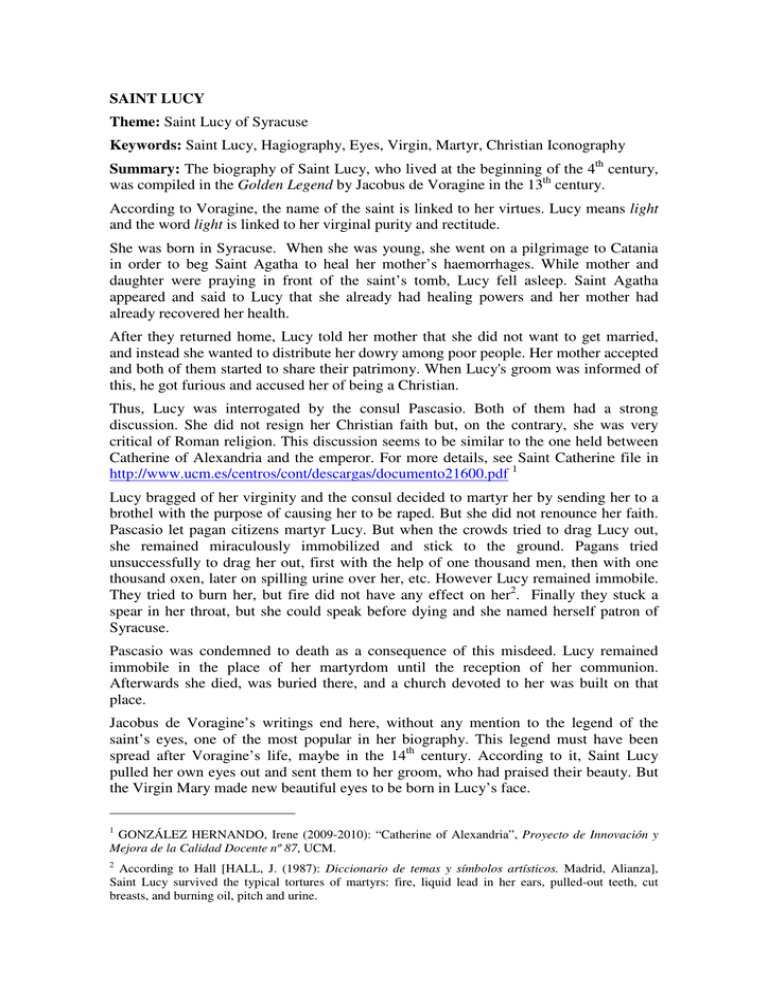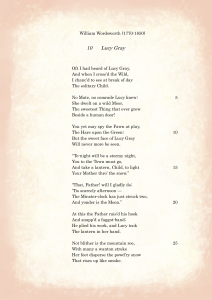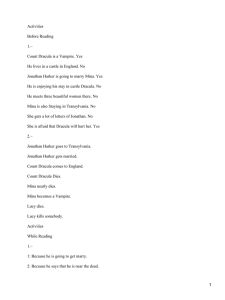Saint Lucy, Hagiography, Eyes, Virgin, Martyr, Christian Iconography
Anuncio

SAINT LUCY Theme: Saint Lucy of Syracuse Keywords: Saint Lucy, Hagiography, Eyes, Virgin, Martyr, Christian Iconography Summary: The biography of Saint Lucy, who lived at the beginning of the 4th century, was compiled in the Golden Legend by Jacobus de Voragine in the 13th century. According to Voragine, the name of the saint is linked to her virtues. Lucy means light and the word light is linked to her virginal purity and rectitude. She was born in Syracuse. When she was young, she went on a pilgrimage to Catania in order to beg Saint Agatha to heal her mother’s haemorrhages. While mother and daughter were praying in front of the saint’s tomb, Lucy fell asleep. Saint Agatha appeared and said to Lucy that she already had healing powers and her mother had already recovered her health. After they returned home, Lucy told her mother that she did not want to get married, and instead she wanted to distribute her dowry among poor people. Her mother accepted and both of them started to share their patrimony. When Lucy's groom was informed of this, he got furious and accused her of being a Christian. Thus, Lucy was interrogated by the consul Pascasio. Both of them had a strong discussion. She did not resign her Christian faith but, on the contrary, she was very critical of Roman religion. This discussion seems to be similar to the one held between Catherine of Alexandria and the emperor. For more details, see Saint Catherine file in http://www.ucm.es/centros/cont/descargas/documento21600.pdf 1 Lucy bragged of her virginity and the consul decided to martyr her by sending her to a brothel with the purpose of causing her to be raped. But she did not renounce her faith. Pascasio let pagan citizens martyr Lucy. But when the crowds tried to drag Lucy out, she remained miraculously immobilized and stick to the ground. Pagans tried unsuccessfully to drag her out, first with the help of one thousand men, then with one thousand oxen, later on spilling urine over her, etc. However Lucy remained immobile. They tried to burn her, but fire did not have any effect on her2. Finally they stuck a spear in her throat, but she could speak before dying and she named herself patron of Syracuse. Pascasio was condemned to death as a consequence of this misdeed. Lucy remained immobile in the place of her martyrdom until the reception of her communion. Afterwards she died, was buried there, and a church devoted to her was built on that place. Jacobus de Voragine’s writings end here, without any mention to the legend of the saint’s eyes, one of the most popular in her biography. This legend must have been spread after Voragine’s life, maybe in the 14th century. According to it, Saint Lucy pulled her own eyes out and sent them to her groom, who had praised their beauty. But the Virgin Mary made new beautiful eyes to be born in Lucy’s face. 1 GONZÁLEZ HERNANDO, Irene (2009-2010): “Catherine of Alexandria”, Proyecto de Innovación y Mejora de la Calidad Docente nº 87, UCM. 2 According to Hall [HALL, J. (1987): Diccionario de temas y símbolos artísticos. Madrid, Alianza], Saint Lucy survived the typical tortures of martyrs: fire, liquid lead in her ears, pulled-out teeth, cut breasts, and burning oil, pitch and urine. Attributes and types of representation: the depiction of Saint Lucy as an isolated figure can be easily recognized thanks to her most common attribute: a pair of eyes placed over a tray or in a coup (she seldom carries the eyes in her hand, as if they were flowers; or stuck in the point of a dagger). However, the eyes as an attribute of Lucy were not depicted before the 14th century, so that in the oldest examples other attributes were represented. These attributes, which could be depicted alone or in group, are: the book (symbol of wisdom), the palm (symbol of any kind of martyrdom), the sword, knife or dagger (which was stuck in her throat, from where a beam of light sometimes arises), one ox under her feet (symbol of the oxen that could not drag her), fire around her feet (symbol of the martyrdom at the stake), and a lamp or candle in her hand (symbol of the light of her name). Regarding her clothes, she usually dresses either like a Roman with tunic and mantle, or she wears a luxurious and fashionable costume. She has long hair and wears a royal or flowery crown, like other virgins and women saints. However, Lucy was also depicted taking part of a narrative cycle, following the legend compiled by Jacobus de Voragine (for more details, see section summary). Among the stories of her biography, the one of the oxen was the most common in works of art. Primary sources: Concerning her iconography, the most important primary source was the Golden Legend by Jacobus de Voragine, from the 13th century, translated into English by CAXTON, William (1483) vol. 2, p. 59, available on http://www.fordham.edu/halsall/basis/goldenlegend/GoldenLegendVolume2.htm#Lucy, last access on 11 October 2010; and into Spanish by MACÍAS Manuel (2001, 1st edition 1982), Alianza, Madrid, vol. I, pp. 43-46. Nonetheless, Voragine must have known the Greek and Latin Legend (5th century), since the biography, worship and iconography of Saint Lucy existed before 13th century. Thus, he just compiled, rewrote, and spread the story of this female saint. Other sources, non written sources: regarding Lucy, the etymology of her name should be considered one of the sources for her iconography. In fact, according to Réau (1955-1959) the legend of the pulled-out eyes must have reinforced the meaning light that was in her name. Thus the symbol of the eyes, which must have been originally just a way to remember the light of Lucy, must have created later on the legend of Lucy pulling them out and sending them to her groom. Geographical and Chronological Framework: The development of Lucy’s iconography is linked to the spreading of her devotion. The interest on Lucy emerged with her death in the 4th century, as it was stated in the martyrologies. Leonardi (2000) explained this process. The tomb of the saint, placed in the Syracuse catacomb, must have been the origin of her devotion, since it was in that place that the Euskia Epigraph was found (end of 4th century or beginning of 5th century); an epigraph that mentions the devotion to Lucy as protector of sight. Thus, in that period, the devotion to Lucy must have been spread at a local level, that is to say in Sicily. Later on her worship was spread thanks to the Roman Church at an extra local level, that is to say all over Italy. Written evidence of this spreading are the Latin Passio and the Sacramentary and Antiphonary of Pope Gregory the Great (6th century), who also included Lucy and Agatha in the Roman canon of mass. Contemporary artistic evidence can be found at the church of Saint Apollinare Nuovo in Ravenna (6th century), where the first depiction of Lucy has been found included among the saints that are walking towards the Virgin Mary. Moreover, at the end of 7th century a church devoted to her was built in Rome under the patronage of Pope Honorius (625-638) According to Réau (1955-1959) the development of Lucy's devotion in the West begins in Italy (Naples, Rome, Milan, Venice, etc.) and continues all over Europe (France, Germany, the Netherlands, Swede, and Spain). According to Fábrega (1953) there is evidence of Lucy's devotion in Spain at the end of the 11th century, when the Visigoth or Mozarab rite was abolished. In fact, in those days the Spanish Passionary included one hundred and fifty saints, being eight of them from Italy, among them Lucy. Following Leonardi (2000), the spreading of the devotion and legend of Lucy took place later on in the Eastern Church than in Western Europe. There are several liturgical evidences of this development: the Greek Martyrion, one Hymn by Methodius (9th century), and the Menology by Saint Basil (end of the 10th century). The quick spreading of Lucy devotion, both in the Western and Eastern Church, explained why there are depictions of her from the 6th century onwards (just see the Virgins procession of Saint Apollinare Nuovo, Ravenna). Depictions can be found all over medieval Christianity, although there were more common in Italy than in other areas. Artistic media and techniques: sculptures and paintings of Saint Lucy were common in the Middle Ages, although there were also examples made in the sumptuary arts, such as enamels (see the ones from Toledo cathedral). Precedents, transformation and projection: the link between Lucy and the light could have encouraged the assimilation of pre-Christian beliefs. In fact, in Northern Europe Lucy’s feast coincided with summer solstice, by assimilating Lucy with the end of darkness and the arising light.3 Depictions of Lucy, either as an isolated figure of taking part of narrative cycles, seem to have emerged in the 6th century and not to have suffered from many changes throughout the Middle Ages. The most noteworthy change of her iconography took place in the 14th century, when her pulled-out eyes placed over a tray or inside a coup were added to her figure. These symbols would become the most common one of Lucy during Modern Times. Typology and related themes: From the 14th century onwards Saint Lucy could be mistaken for Saint Odile, since this other female saint also has a pair of eyes, although they are over a book and not over a tray. Lucy is also iconographically linked to Catherine of Alexandria. Both of them have common symbols, such as the sword (Lucy’s throat was damaged by a sword and Catherine was decapitated maybe with a sword), the book (Lucy and Catherine were praised thanks to their wisdom and had strong discussions in front of pagan authorities), and the palm (linked to the martyrdom and common to all the martyr saints). Moreover both of them dress on similar rich clothes and wear crowns. Images: - 3 Lucy among the procession of the virgins and martyrs, Saint Apollinare Nuovo, mosaics, 6th century, Ravenna (Italy). RÉAU, Louis (1996-2002): Iconografía del arte cristiano. El Serbal, Barcelona, Part 2 – Volume 4, p. 269 - Santa Lucía de Mur, narrative cycle (Lucy in front of the emperor, whipped, burned at the stake and decapitated), panel painting, coming from the church of Santa Lucía de Mur (Guàrdia de Noguera, Pallars Jussà), ca. 1300, Museo de Arte de Cataluña, Barcelona (Spain) - Altichiero da Zevio, Saint Lucy’s Life (martyrdom at the stake and funerals), fresco painting, 1379-84, Oratorio di San Giorgio, Padua (Italy) - Estimariú Master, Altarpiece devoted to Saint Lucy’s Life (visit to Saint Agatha’s tomb, distribution of money among poor people, discussion with Pascasio, the immobile saint, Lucy dragged by oxen, martyrdom at the stake, last communion and burial), panel painting, 14th century, Prado Museum, Madrid (Spain). - Saint Lucy Reliquary, Saint Lucy’s Life (distribution of money among poor people, discussion with Pascasio, Pascasio and the soldiers, Lucy dragged by oxen, martyrdom at the stake, Lucy in prison, burial), enamel, 14th century, Toledo Cathedral (Spain). - Anonymous, Saint Marguerite, Saint Librada and Saint Lucy (with the eyes over a tray), fresco painting, 15th century, Capilla de Montalto Dora, Turin (Italy). - Bernat Martorell, Martyrdom of Saint Lucy (at the stake), tempera on panel, 14351440, Museo Nacional de Arte de Cataluña, Barcelona (Spain). - Andrés de Melgar, Saint Apolonia, Saint Lucy (with the eyes over a tray) and Saint Barbara, oil on panel, 1530-1537, Museo Nacional de Arte de Cataluña, Barcelona (Spain) Bibliography BUTLER, A. (1991): Vidas de los santos. Madrid, Libsa. COULSON, J. (1964): Dictionnaire historique des saints. Paris, Société d’édition de dictionnaires et encyclopédies. VORAGINE, Jacobus (ca. 1230-1298): Golden Legend [Translated into English by CAXTON, William (1483) available on http://www.fordham.edu/halsall/basis/goldenlegend/ last access on 4 October 2010. Translated into Spanish by MACÍAS, José Manuel (2001, 1st edition 1982): Santiago de la Vorágine. La leyenda dorada. Alianza, Madrid, vol. I-II] DELEHAYE, H. (1933): Les origines du culte des martyrs. Brussels, Société des Bollendistes. DUCHET-SUCHAUX, G. y PASTOUREAU, M. (1996): La Biblia y los Santos. Guía iconográfica. Madrid, Alianza. FÁBREGA GRAU, A. (1953): Pasionario hispánico. Siglos VII – XI. Vol. I. Barcelona, CSIC. GIORGI, R. (2002): Santos. Barcelona, Electa. HALL, J. (1987): Diccionario de temas y símbolos artísticos. Madrid, Alianza. LEONARDI, C. (2000): Diccionario de los santos. 2 vols. Madrid, San Pablo. MARTÍNEZ ARANCÓN, A. (1978): Santoral extravagante. Una lectura del Flos Sanctorum de Alonso de Villegas. Madrid, Editora Nacional. METFORD, J.C.J. (1983): Dictionary of Christian Lore and Legend, London, Thames and Hudson. RÉAU, Louis (1996-2002): Iconografía del arte cristiano. El Serbal, Barcelona, Part 2 – Volume 4, pp. 267-271 [Translated from RÉAU, Louis (1955-1959): Iconographie de l’art chrétien. 3 vols. Presses Universitaires de France, Paris] ROIG, J.F. (1950): Iconografía de los Santos. Barcelona, Omega. ROMAN, M.T. (1999): Diccionario de los santos. Madrid, Alderabán. SILVA MAROTO, M.P. (1990): Pintura hispanoflamenca castellana: Burgos y Palencia. Valladolid, Junta de Castilla y León. Author and email address: Irene González Hernando [email protected]



